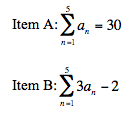Ch 12. Sequences and Series
1/31
There's no tags or description
Looks like no tags are added yet.
Name | Mastery | Learn | Test | Matching | Spaced |
|---|
No study sessions yet.
32 Terms
If 55 and 89 are two sequential terms of the Fibonacci sequence, what term would come next?
Which group of numbers does not appear to be a sequence with a set pattern?
4, -13, 1, 5, 16, ...
10, 30, 90, 270, 810, ...
4, 10, 16, 22, 28, ...
13, 6, -1, -8, -15, ...
256, 128, 64, 32, 16, ...
4, -13, 1, 5, 16, ...

In the sequence 9, 14, 19, 24, 29,.... Say we're using a to describe the terms. What is the value of the term below?
19
29
24
9
14
19
Which sequence below is a geometric sequence?
6, 8, 11, 14, 18, ...
5, 15, 45, 135, 405, ...
0, 1, 1, 2, 3, ...
2, 3, 4, 5, 6, ...
14, 16, 18, 20, 22, ...
5, 15, 45, 135, 405, ...
If a2 = 5 and a8 = 35, what is the value of a30?
185
245
150
145
158
145
What is the 83rd term of the sequence 91, 87, 83, 79, ... ( = a1, a2, a3, a4, ...)?
-237
-233
-229
-243
-247
-237
What is the rule for the nth term of the sequence with a7 = 53 and a13 = 101?
an = 5n + 8
an = 8n + 5
an = 8n - 3
an = 8n + 3
an = -3n + 8
an = 8n - 3
A brick wall has 60 bricks in the first row, but each row has 3 fewer bricks than the previous one. How many bricks are in the 12th row?
27
21
24
30
33
27
A brick wall has 60 bricks in the first row, but each row has 3 fewer bricks than the previous one. How many bricks are in the 12th row?
27
21
24
30
33
27
Which of the following sequences is NOT a geometric sequence?
9, 27, 81, 243, 729, ...
1, 8, 15, 22, 29, ...
2, 4, 8, 16, 32, ...
100, 50, 25, 25/2, 25/4, ...
5, 15, 45, 135, 405, ...
1, 8, 15, 22, 29, ...
Choose the equation below that represents the rule for the nth term of the following geometric sequence: 128, 64, 32, 16, 8, ...

Which equation below represents a geometric sequence?

Which of the following is the 14th term of the sequence below?
11, 22, 44, 88, 176, ...
8,192
90,112
16,384
45,056
180,224
90,112
Find the rule for this series: 2 + 6 + 18 + 54 + ...

Express this series using sigma notation: 5 + 6 + 7 + 8 + 9 + 10...

What's the difference between a sequence and a series?
A series is an ordered list of numbers, and a sequence is the sum of a series' terms.
There is no difference because both terms describe the same mathematical expression.
A series can be infinite, but a sequence must always be finite.
A sequence is an ordered list of numbers, and a series is the sum of a sequence's terms.
A sequence is an ordered list of numbers, and a series is the sum of a sequence's terms.
Express this series using sigma notation: 3 + 5 + 9 + 17 + 33.


Evaluate the following sum:
15
24
6
8
9
15

Which choice below represents an arithmetic series?
10 + 30 + 90 + 270 + 810
12 + 10 + 8 + 6 + 4
5, 25, 125, 625, 3, 123
1 + 4 + 9 + 16 + 25
6, 10, 14, 16, 22
12 + 10 + 8 + 6 + 4
Find the sum 1 + 8 + 15 + 22 + 29 using the formula for an arithmetic series.
100
29
75
70
75

In the formula for calculating an arithmetic series, what does the following term represent?
The difference between each term in the series
The last term in the series
The first term in the series
None of the answers are correct.
The first term in the series
A brick wall contains 52 bricks in its bottom row and 49 bricks in the next row up from the bottom row. Each subsequent row contains 3 fewer bricks than the row immediately below it. If the wall contains 16 rows, how many bricks total make up the wall?
720
472
518
360
944
472

Find the sum of the following geometric series:
2,048
2,044
1,024
174,763
511
2,044
A ball is dropped and begins bouncing. On the first bounce, the ball travels 3 feet. Each consecutive bounce is 1/8 the distance of the previous bounce. What is the total distance that the ball travels after it first hits the ground? Round to the nearest hundredth.
1.10 feet
3.43 feet
2.63 feet
24.00 feet
3.75 feet
3.43 feet

Find the sum of the following geometric series:
3
The sum of all terms for a finite geometric series is found by:


If a geometric series begins with the following term, what would the next term be?


Evaluate the following:
364
121
242
728
728

Given item A, which of the following is the value of item B?
28
88
78
80
80
What is the sum of all the even integers from 2 to 250?
8,256
15,750
10,120
12,400
15,750

Evaluate the following:
97
727.5
402
533.5
402
A ball is dropped from an unknown height (h) and it repeatedly bounces on the floor. After each bounce, the ball reaches a height that is 2/3 of the height from which it previously fell. Which of the following represents the distance the ball bounces between the first and seventh bounces with sigma notation?




















